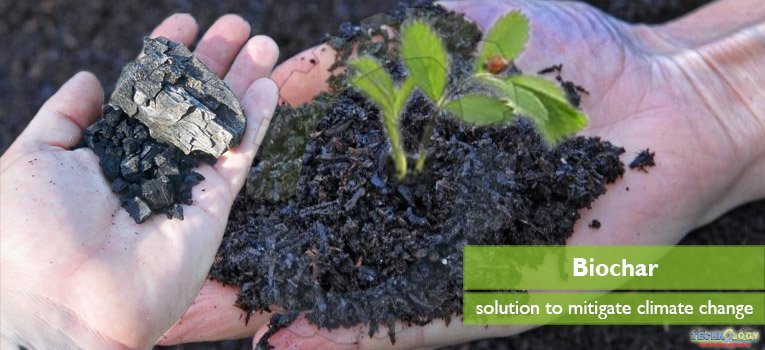We need efficient management to use natural resources in environment friendly way. We get everything from our soils. Without productive soils, we have nothing to eat and wear. The integrated solution strategy is application of biochar in soils that can reduces GHG and captured gas emissions.
Agriculture is the backbone of Pakistan. So we will care about soil productivity and crop production. The developing countries like Pakistan are more affected due to climate change. Agriculture is a major source of GHG (greenhouse gas) emissions. The nitrous oxide release from inorganic and organic fertilizers application are the major contributor from agriculture sector.
Researchers are doing work how we can reduce gas emission and increase nitrogen use efficiency in existing and modern cropping system. There are many practices through which we can increase carbon storage in soils and water conservation for farming in this alarming situations.
The integrated solution strategy is application of biochar in soils that can reduces GHG and captured gas emissions.
Farmers aware about compost and manure preparation and their use. But the concept of bio char is modern. The temperature of earth is rising gradually. We need those products whose efficiency and shelf life high at higher temperature.
Biochar is produced by process of pyrolysis under oxygen deprived condition at 300 degrees centigrade to 700 degrees centigrade. Most agronomic residues are not favorable for high temperature energy conversion process due to high alkali content. Therefore, residues in this thermal process changes to lower temperature in order to avoid operational problems. This is very suitable for biochar production.
Bio char mitigate adverse effect of climate change
Bio char is referring to “the production of black carbon and to manage carbon for mitigation effects of climate change and its application improves soil and maintain sustainable agriculture. It is also called black gold of agriculture. The quality of soil is directly proportional to amount of carbon in the soil.
The agriculture yields increase at higher level of carbon presence in soil. Now in current scenario of climate change and global warming the atmospheric carbon has sequestrated in to soil carbon fixation and results warming could be reduced.
Production process
The raw material consists of agriculture wastes, rice husks, bagasse, animal wastes, urban wastes and paper products. It retains carbon approximately 10% to 70% in the original biomass and lower the decomposition rate in the scale of centuries or millennia.
The pyrolysis process provides process of agronomic wastes, municipal waste and other wood materials into clean energy productive product. In semiarid and desert climate biochar application is very effective to improve soil organic matter, soil biological activity and higher plant moisture absorption.
It can be produced in small cook stoves to large commercial pyrolysis units. Due to wide range of temperatures it could be applied to a diversity of soil types. Different production conditions can result in different types of bio chars.
Beneficial uses of biochar in sustainable agriculture
The biochar is very important for sustainable agriculture. Some of the beneficial uses are listed below.
- Improved soil fertility and productivity
- Improved soil tilt, aeration water holding capacity
- Higher CEC (cation exchange capacity) and lower nutrients runoff
- Higher FUE (fertilizer use efficiency)
- Increasing soil organic matter
- Higher farmer profit
- Decrease emission of nitrous oxide and methane from soil
- Increase reversing of desertification
- Best alternative practice for burning of residues
- By products like bio oils and hydrogen fuels and can produce electricity
- It is best liming agent for reducing acidity of soil
- Bio energy is produced
- Carbon sequestration by the natural process of photosynthesis
Biochar application methods and rate
Biochar can be incorporated in the soil by different methods like broadcasting, banding and spot placement etc. But it is depending on farming system. Different experiments showed that biochar application rate 5-50 ton per hectare have been used worldwide successfully.
Application of biochar in soil where leguminous crops grown shows higher results. The characteristics of biochar depends on raw material used. This is also influenced application rate. Biochar amendment improves soil with passage of time and it’s also depends on splitting application over time
Disadvantages of biochar
Biochar has its own disadvantages. It is inactivating chemicals which has important function in soil with respect to crop yield. Bio char is act like a sorbent for many chemical compounds like herbicides, heavy metals and insecticides. It is reducing absorption of chemicals by plants.
Always keep in mind the raw materials for your biochar production and it should be tested and also meet the requirements of purpose. When you will apply biochar precaution measures must be followed. The small particles of biochar can infect respiratory system and even cause cancer.
These risks are associated with those people who are working on it for prolong period. The best practice is using face mask during working with it. Health is wealth. Care about your health while working with chemical.
Importance of biochar industry
Biochar industry creates job opportunity for unemployed people. It improves existing agronomic ecological practices and helps in sustainable management of soil. It creates business opportunities among people. This process will improve through research. This system advances community economically. However, bio char has potential for improving sustainable agriculture management.
